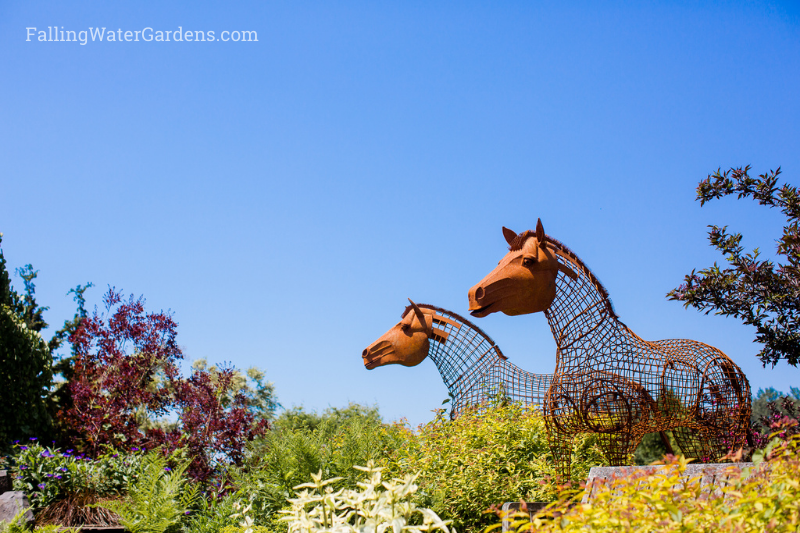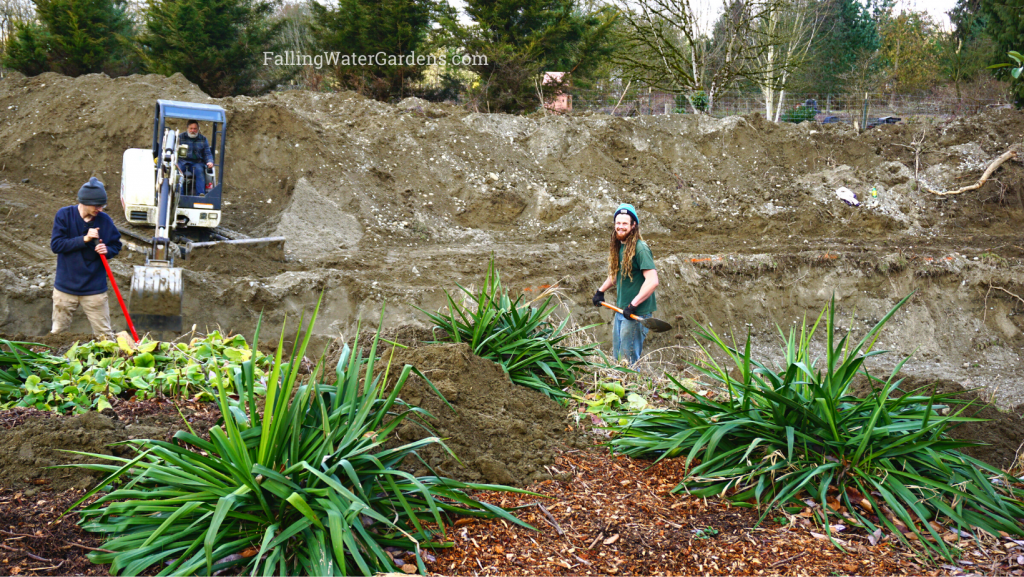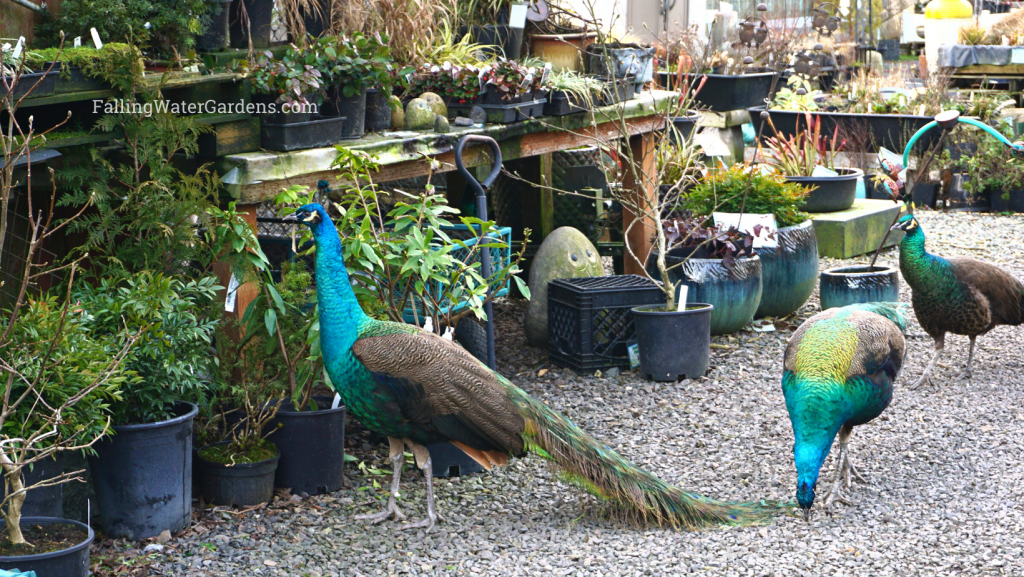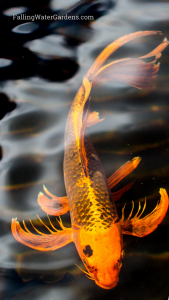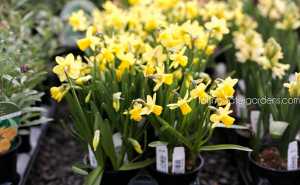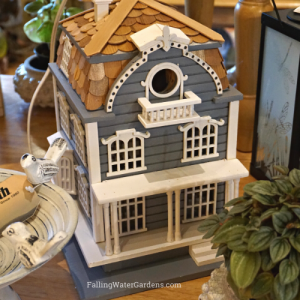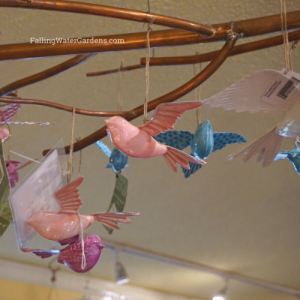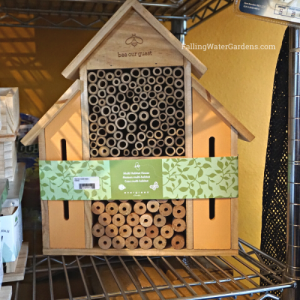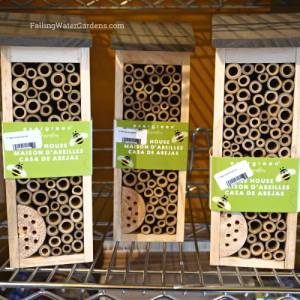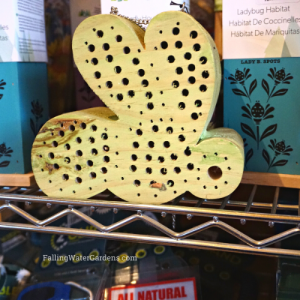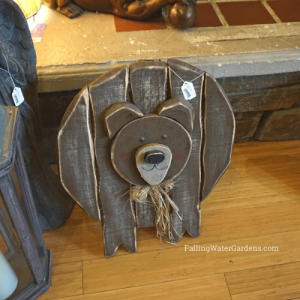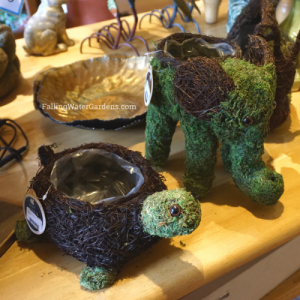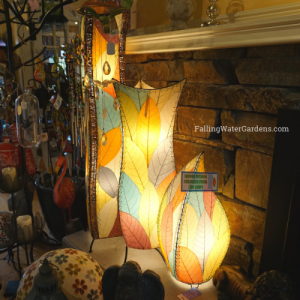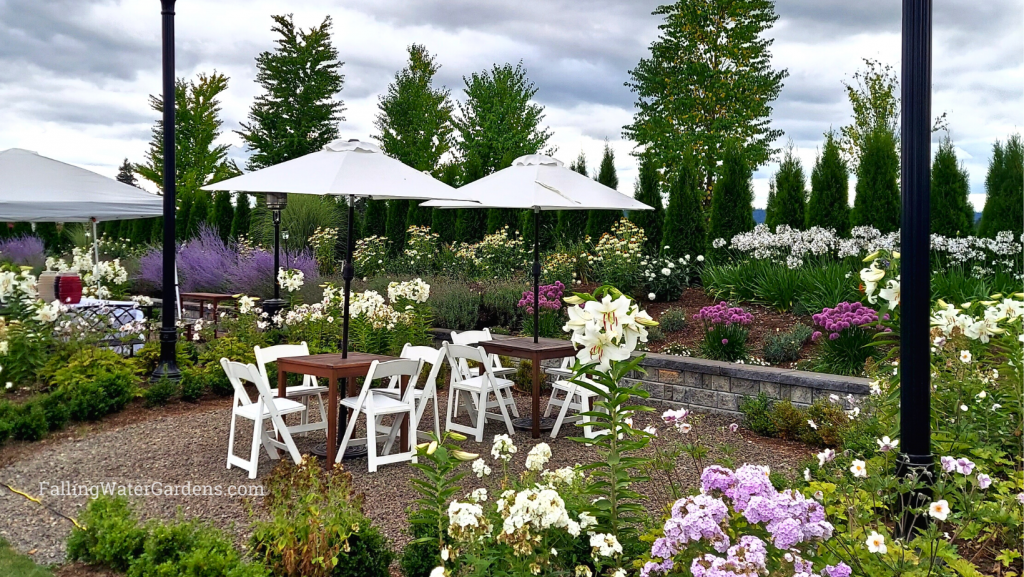Hello March!
Spring will be here soon and we are excited to get our gardens ready! In this newsletter you will find some fun things we have going on around the nursery, as well as all things Mason Bees, our featured plants for March and so much more!
Nursery News
Time to brush away the winter debris and rise and shine! Like you, we are busily working on preparing our nursery for the 2022 season and our inventory is growing by the minute! Our landscape crew is keeping busy with pond maintenance, and new installations. We are hiring full-time and part-time for our Nursery Sales Positions, Gardener Positions, and a Lead Gardener. Check out the last tab of the newsletter to learn more!
In this issue, you will find important information on garden preparation, Koi and Gold Fish, and Mason Bees. We have featured some plants that will make a great addition to your garden, featured items in our gift shop, and finally an update about our event venue!
We are looking forward to seeing you this Spring!
The Importance of Mason Bees
 To bee or not to bee, that is the question. This is the time of the year when we start preparing our gardens for Spring. We think about what we want to plant and more importantly how we want our garden to thrive.
To bee or not to bee, that is the question. This is the time of the year when we start preparing our gardens for Spring. We think about what we want to plant and more importantly how we want our garden to thrive.
Let us introduce to you, the Mason Bee!
Mason Bees help get gardens, and especially fruit trees, pollinated early in the season. Mason Bees are significantly more effective at pollinating a garden than Bumble or Honeybees. Unlike the Honey or the Bumble bee, Mason Bees do not have a hive, so the pollen they collect stays in their possession. They are less tidy transporting the pollen they collect so more pollen gets spread across many more flowers. Mason Bees are so docile it is nearly impossible to get one to sting so you don’t need to fear them.
When do the Mason Bees get to work?
Mason Bees start to emerge in early spring when
 Your Bee Houses
Your Bee Houses
Mason Bees lay their eggs in small hollow holes or tubes. Mason Bee houses are a collection of perfectly sized tubes to ensure you get a large colony of Mason Bees next year.
Place Mason Bee houses in an area near the spaces you want pollinated. Mason Bees need to be located close to the area you want them to pollinate because they fly far shorter distances than honey bees. Mason Bees love morning sunshine, so you should look for an east or south facing spot.. A fence or wall or side of a building is good. Avoid a spot under a swaying branch since the bees don’t like dappled shade. Your spot should be well above ground.
Getting Started in your Mason Bees
We have everything you need to be successful with Mason Bees. We always sell out of Mason Bees so visit the gift shop now!
Ceramic Pot Water Features
Many homeowners spend very little time in the front garden so when installing a water feature in the front garden it is often “for the neighbors” or your guests on their way to your front door. When asked for ideas for a front water feature we often suggest basalt columns or ceramic pots because they are less costly than a fish pond or waterfall. Ceramic water features are a great way to get sound and visual interest in a small space and ceramic pot water features can offer a pop of color when needed in a garden.
Ceramic pots can be either self-contained or overflow. Self-contained pots have a pump inside that gurgles the water inside the pot. They make a beautiful sound, are very affordable and need very little space. Overflowing ceramic pot water features are more visually stunning because you see the water flowing over the sides of the pot, but they require more room in the garden and are more costly than self-contained pots.
Overflowing pots can be either smooth sided or rough sided pots. Smooth sided pots allow the water to gently run down the side of the pot and there will be very little splash so the reservoir underneath the pot can be quite small, but the sound will also be quieter. Rough sided pots will have the water falling at the first ridge so the water will be falling much higher up, which looks stunning and is louder, but causes more splash. The reservoir under a rough-sided pot must be larger to catch the splash from the falling water.
Ceramic pot water features do not need to be only a single ceramic pot. We have installed many ceramic pot water features that are groups of pots.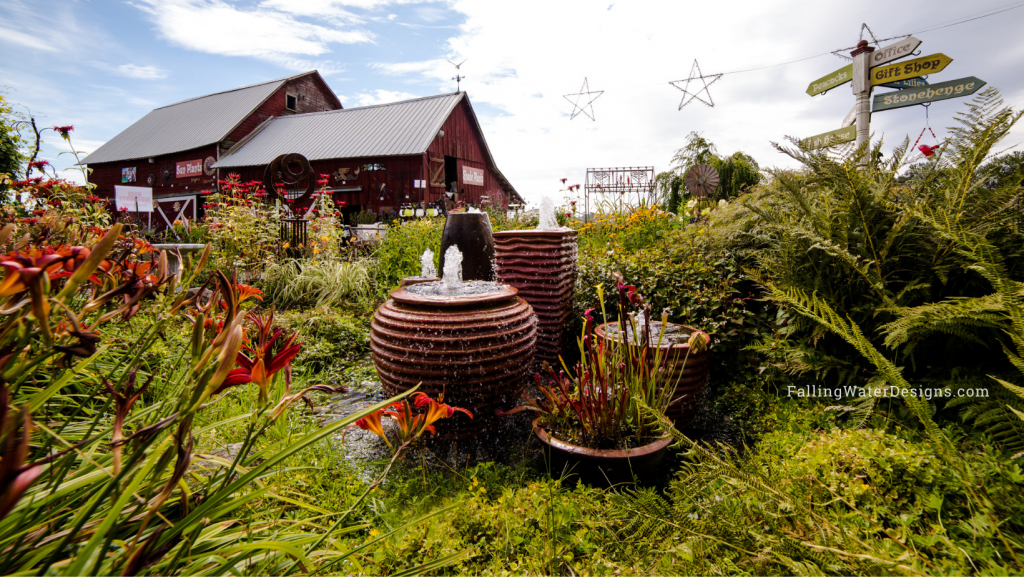
If you need a pop of color in your garden or want a more affordable water feature consider one of the many ceramic pot water features at Falling Water Gardens.
Featured Koi of the Month
Hirenaga
Also known as Butterfly Koi, Hirenanga have long fins, the tail and fins should be solid without tears and ideally should be symmetrical. They can have longer more slender bodies as it adds to their elegance. Hirenaga koi are the butterflies of the water, and are known for their graceful, flowing fins. The style of these butterfly type koi are very popular!
Common Questions: When To Feed Your Koi
Water Temperature & Fish Hibernation:
Fish conserve energy by remaining closer to the bottom of the pond when the water temperature is below the mid 50°F’s. This is their way of hibernation, called Torpor.
Fish are cold-blooded animals:
Fish do not generate their own body heat, and their body temperature is reliant on both water temperature and their environment.
When do I feed?
Once the temperature of your pond water is consistently above 50°F, it is safe to feed your fish all-season fish food again. Do you know the temperature of your pond? We sell pond thermometers at the nursery or you can check our webpage for the current temperature in our nursery Koi pond.
For recommended foods, please read all about feeding your aquatic friends here
Garden Tasks for March
It is now time to break out your gardening gloves and get your garden prepared for planting and blooming!
TASK 1: Clearing
It is a great time to move away debris, as well as clear dead steams, because this is our last opportunity to do so before new growth. You see, if you have new growth, it makes it challenging to know what to trim back.
Task 2: Dividing
Take a look around your garden and see what you can possibly divide and plant. If you see areas of congested plants like iris’ or geraniums, actually anything with lots of stems, you can divide. Dividing and replanting allows you to decrease overall garden congestion, see what areas need to be filled in with complimentary plants or areas that need complete replacement and support.
Task 3: Early Planting
If you have areas within your garden for edible plants/crops now a good time to plant permanent crops like asparagus and strawberries, and also early plantings of crops of shallots, potatoes and onions.
Task 4: Pond Cleaning & Scheduling Maintenance
If you do not have fish in your pond, you may clean your pond this month. If you do have fish in your pond wait until the water temperature is at a consistent 50° degrees as your fish are immune suppressed below 50. In our area fish ponds reach 50 closer to April.
If you are a DYI person, you may visit our nursery to purchase your pond supplies. We have a great article on Spring Pond Maintenance and check out this great video on how to clean your pond.
If you want to schedule a professional pond cleaning by our crew, email us to get your pond cleaning scheduled. Info@FallingWaterDesigns.com
Task 5: Stop by the Falling Water Gardens Nursery
Now that you have taken an inventory of plants, garden décor, and garden and pond supplies, stop by our nursery and giftshop to pick up what you need.
Featured Plants
Here are this month’s featured plants. We think this selection would look great in your garden right now. Visit our plant database to learn more about aquatic & terrestrial plants. Click on the name of the plants below to learn more about each plant.
Bulbs
Unlike Tulips that rarely come back next year, Daffodils and Hyacinth will rebloom each year, slowly building a colony of beautiful early spring color. Daffodils and Hyacinth are usually planted as bulbs in the Fall, but if you didn’t get around to that we have many varieties and colors in 4” pots already blooming and ready to be taken home for planters or the garden.
Narcissus ‘Tete-a-Tete’
The happiest little spring blooming bulb! Bright yellow flowers in early spring are easy to grow in full sun to part shade in average soil. Lovely cut flowers are long lasting. Strappy green reflexed foliage.
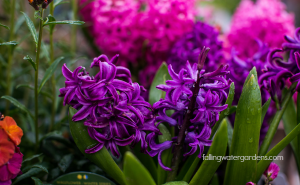 Hyacinth
Hyacinth
Hyacinths are spring-blooming bulbs with richly colored flowers and an incredible fragrance that can perfume your entire garden. They bloom in mid-spring at the same time as daffodils and early tulips, and come in a rainbow of colors including white, cream, pink, rose, apricot, lavender, cobalt blue, deep purple and wine red. Like other spring-flowering bulbs, hyacinths are easy to grow. Just plant the bulbs in fall to enjoy beautiful flowers the following spring.
Spring Annual Color
Tired of dreary winter beds or planters? We have so much Spring Annual Color at the nursery right now. Primula, Tulips, Spring Pansies, Bellis and much more. Come check them out.
Primula
Primroses combine fabulously with spring bulbs and evergreen grasses. An explosion of color in every shade of the rainbow, primroses primarily prefer cooler temperatures and therefore bloom early spring through May.
 Tulipa
Tulipa
Single Early Tulips are excellent for cut flowers, forcing and for early spring display, after which they may be removed in time for seasonal summer plantings. These lustrous, cup shaped tulips bloom long before any of their longer-stemmed siblings. Featuring strong stems, they stand up well to rain or wind and open fully in sunny weather. They are excellent bedding and forcing tulips as well.
Spring Pansies
Pansies are planted during cool spring or fall months. Pansies prefer sites that provide full, direct morning sun, yet shield them from intense afternoon rays. Pansies require well-drained, fertile soil .
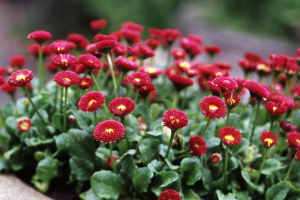 Bellis
Bellis
A colorful carpet of flowers for the Spring garden. Attractive with pansies or Spring bulbs; ideal as a small-scale groundcover, in rock gardens or at garden’s edge. Plant in a cool site with moist soil for best performance and continued reblooming.
Perennials
 Dicentra ‘Gold Heart’
Dicentra ‘Gold Heart’
The old-fashioned Bleeding Heart has been a garden favorite for years. It’s a substantial plant that bears long, arching racemes of pink flowers. ‘Gold Heart’ is a classic beauty with one marvelous variation: It has metallic gold leaves and peach-colored stems instead of the usual green. Bloom starts here in early May and lasts several weeks, subsiding with the arrival of summer heat. Plants often go dormant in midsummer (interplant with Ferns and Hostas to fill the breach). Long-lived, reliable, and will self sow.
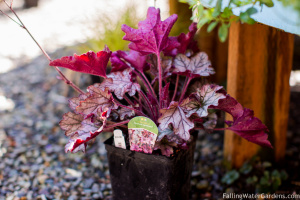 Heuchera ‘Spell Bound’
Heuchera ‘Spell Bound’
Marvelous ruffled foliage of dazzling silvers with tints of rose purple will leave you spellbound. The purple tones are more prominent in the spring and fall. Silver tones are more prevalent in shade. It forms a big plant with a dense, multi-crown habit. Great in containers or in the landscape.
 Heuchera ‘Marmalade’
Heuchera ‘Marmalade’
Dramatic foliage ranges from deep golden to glowing reddish-pink with undulating margins. Golden mature foliage features contrasting hot pink undersides. A vigorous grower of heavy substance that is showy in many seasons.
House Plants
Jealous of your friend’s house plant collection? Do you have your own house plant collection and need another to add?
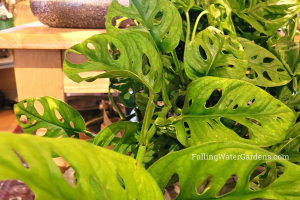 Monsteria adansonii
Monsteria adansonii
Monstera adansonii is an easy to grow houseplant. This variety is more delicate than deliciosa and grows beautiful and delicate vines. Plant it in a pot with drainage holes and use a standard potting soil that contains peat. Peat helps trap the moisture without becoming waterlogged. This is a great plant to place in a hanging basket or on a high shelf where its trailing vines won’t get in the way. Place near a window where the plant can get bright, but indirect, sunlight. You may trim the vines if they start to look scraggly to encourage new growth.
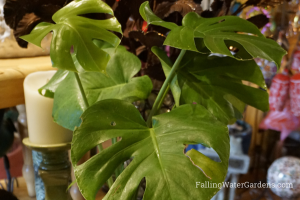 Monsteria deliciosa
Monsteria deliciosa
Monstera deliciosa is know for its natural leaf holes. In nature, these holes were thought to allow the sunlight to reach the forest floor. Young plants may come without any holes and develop holes as it matures over time. For planting use a well-draining soil, using lava rocks perlite can help to increase aeration. This house plant requires indirect to medium sunlight. Monsteras typically require a higher level of humidity, so you may need to consider a humidifier in the winter. Use caution as Monsteras can be toxic to pets, so it is best to keep them out of reach of kids and pets.
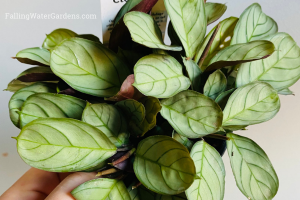 Ctenanthe setosa
Ctenanthe setosa
Ctenanthe setosa will capture your attention with its silvery-blue variegated leaves, rosy colored stems, and purplish leaf undersides. Ctenanthe are commonly called Prayer Plants because their leaves lie flat during the day and then fold upwards in the evenings. Ctenanthe setosa grows a bit taller than other members of the genus. High humidity helps Ctenanthe setosa thrive – mist periodically.
 Peperomia obtusifolia ‘Marble’
Peperomia obtusifolia ‘Marble’
The Peperomia obtusifolia is characterized by its thick, upright stems with glossy, spoon-shaped leaves, which store water. In its natural habit, the plants leaves will shrivel in drought and plump after it rains. The leaves are typically a vibrant green but can also have white-and-green variegation that resembles marbling. Peperomia needs bright to medium indirect sunlight. You should water your plant every 1-2 weeks allowing soil to dry completely between watering. A sign of overwatering is leaves turning yellow and then dropping. Peperomia obtusifolia is pet-friendly!
Plant Database
 Have you checked out our plant database? It contains information about the plants that we sell at the nursery and more!
Have you checked out our plant database? It contains information about the plants that we sell at the nursery and more!
We have even taken it one step further and have incorporated QR codes into the database to help you save and recall information on the plants you are interested in at home or have bought from our nursery. You can bring us the saved plants from this data base to help us locate the ones you want. As well as when you come to Falling Water Gardens you will be able to scan the plant signs to get further information about the plants and flowers.
 What is a QR code? In the simplest terms a QR code is a bar code. Most smart phones come equipped with a bar code/QR code reader that will scan the QR code and bring you to the web page of information about our plants. From there you can bookmark the page. If yours does not contain a QR code reader already, you can download one for free through your phone’s app store.
What is a QR code? In the simplest terms a QR code is a bar code. Most smart phones come equipped with a bar code/QR code reader that will scan the QR code and bring you to the web page of information about our plants. From there you can bookmark the page. If yours does not contain a QR code reader already, you can download one for free through your phone’s app store.
Gift Shop
Birds
Mason Bees
& Everything in Between
Wedding & Events Venue
Are you getting married this year and still looking for a venue? We still have 2020 & 2021 dates available. Contact us for more information and visit our wedding site to learn more.
Falling Water Gardens is Hiring!
We are currently hiring for Nursery Sales and Gardener positions! Review the positions listed below, apply to come work with us!
Nursery Sales Position

Our company has an immediate need for FULL OR PART-TIME SEASONAL nursery workers.
Enjoy working outside while developing your nursery skills and growing with a great, well-known company in Monroe, Washington.
Applicants who can demonstrate previous retail experience and/or plant knowledge are preferred. Previous retail sales experience is required.
This position assists the Nursery Manager in maintaining the plant material, surrounding gardens, and fish tanks. This is a very physical job requiring frequent lifting of 50 lbs. You must be able to work outside in rain or shine, cold or hot.
Tasks include:
-
Assisting customers with purchases
-
Stocking the benches and gift shop
-
Digging, Edging, Mowing, Pruning, Planting, and Watering the nursery
Our nursery is open 7 days a week, from 10am till 6pm. You will be required to work AT LEAST ONE WEEKEND DAY per week.
Interested applicants should respond to this email with a resume and must answer the questions at the end of this ad. Please mention the Nursery Sales Position in your email. Please, no phone inquiries.
Position pays DOE. Nursery Sales $15-$17 per hour.
Applications without the following questions answered will not be considered.
Question #1: What applicable experience have you gained at previous jobs that you think will be helpful to our company?
Question #2: What has been your most physical job to date, or why do you think you will be able to handle a job as physical as this one?
Please answer the questions above and send your resume to info@fallingwaterdesigns.com.
Gardener Position
We are a destination nursery located in Monroe, Washington with many established garden beds and turf. Our company has an immediate need for PART-TIME or FULL-TIME SEASONAL gardeners.
Enjoy working outside while developing your nursery skills and growing with a great, well-known company in Monroe, Washington.
This position assists the Nursery Manager maintaining the surrounding gardens, turf and fish tanks. This is a very physical job requiring frequent lifting of 50 lbs. You must be able to work outside in rain or shine, cold or hot.
This position is primarily responsible for weeding, pruning, and planting new and established garden display beds throughout our nursery as well as maintaining the turf. This position requires frequent stooping, squatting, kneeling, bending and twisting. This position requires an individual who can work without direct supervision and who can take initiative and keep busy.
Tasks include:
Digging, Weeding, Edging, Mowing, Pruning, Planting, Watering, Occasionally assisting customers with loading.
Our nursery is open 7 days a week, from 10am till 6pm. You will be required to work AT LEAST ONE WEEKEND DAY per week.
Interested applicants should respond to this email with a resume and must answer the questions at the end of this ad. Please mention the “Gardening Crew” position in your email. Please, no phone inquiries.
The position pays DOE. Gardening Crew $14-$16 per hour.
Applications without the following questions answered will not be considered.
Question #1: What applicable experience have you gained at previous jobs that you think will be helpful to our company?
Question #2: What has been your most physical job to date, or why do you think you will be able to handle a job as physical as this one?
Please answer the questions above and send your resume to info@fallingwaterdesigns.com.
Lead Gardener
We are a destination nursery located in Monroe, Washington with many established garden beds and turf. Our company has an immediate need for a PART-TIME or FULL-TIME LEAD GARDENER.
This job requires previous maintenance gardening experience to be considered for the position. Applicants must be able to demonstrate several year’s professional experience working on a maintenance landscaping crew through their employment history.
**This is not an entry-level gardener position.
Have you worked on a landscape maintenance crew in the past and would enjoy working at the same garden every day? Tired of starting work at 7am? Our nursery opens at 10am! You can work full or part-time, your choice.
This position assists the Nursery Manager in maintaining the surrounding gardens, turf, and fish ponds. This is a very physical job requiring frequent lifting of 50 lbs. You must be able to work outside in rain or shine, cold or hot.
This position is primarily responsible for weeding, pruning, and planting new and established garden display beds throughout our nursery as well as maintaining the turf. This position requires frequent stooping, squatting, kneeling, bending, and twisting.
This position requires an individual who can work without direct supervision and who can take initiative and keep busy.
Tasks include:
Digging, Weeding, Edging, Mowing, Pruning, Planting, Watering, Occasionally assisting customers with loading.
Our nursery is open 7 days a week from 10am until 6pm. You will be required to work AT LEAST ONE WEEKEND DAY per week.
Interested applicants should respond with a resume. Please mention the “Lead Gardener” position in your email. Please, no phone inquiries.
The position pays DOE. Gardening Crew $18-$24 per hour.
Applications without the following questions answered will not be considered.
Question #1: What applicable experience have you gained at previous jobs that you think will be helpful to our company?
Question #2: What has been your most physical job to date, or why do you think you will be able to handle a job as physical as this one?


